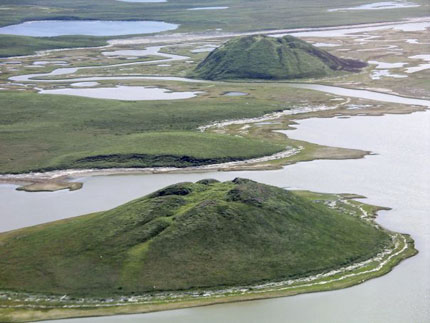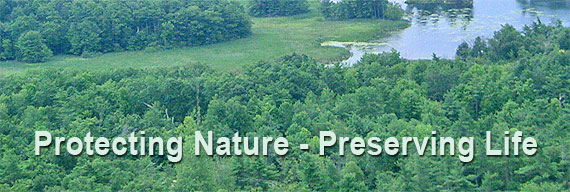|
Imagine hiking in a National Park at the top
of the world, where
caribou spend the summer. Canoe a wild northern river few have ever
seen. Hop a bush plane and go flightseeing over the Nahanni, the
Mackenzie Delta, or Great Slave Lake's East Arm. Or relax aboard a jet
boat, and travel a northern river to a secluded mountain lodge.
Aulavik
National Park - Aulavik,
meaning “ place where people travel ” in
Inuvialuktun, protects more than 12,000 square kilometres of arctic
lowlands on the north end of Banks Island. The park encompasses a
variety of landscapes from fertile river valleys to polar deserts,
buttes and badlands, rolling hills, and bold seacoasts. At the heart of
Aulavik is the Thomsen River, which offers visitors a chance to paddle
one of the continent’s most northerly navigable waterways. This
pristine arctic environment is home to both the endangered Peary
caribou and to the highest density of muskoxen in the world. The
wildlife and land have supported aboriginal peoples for more than 3,400
years, from Pre-Dorset cultures to contemporary Inuvialuit.
Nahanni
National Park Reserve and UNESCO World Heritage Site - Nahanni
National Park Reserve of Canada protects a portion of the
Mackenzie Mountains Natural Region offering the adventurous visitor a
wilderness experience. A key feature of the park is the Naha
Dehé
(South Nahanni River). Four great canyons line this spectacular
whitewater river. At Nailicho (Virginia Falls) the river plunges in a
thunderous plume. The park's sulphur hotsprings, alpine tundra,
mountain ranges, and forests of spruce and aspen are home to many
species of birds, fish and mammals. A visitor centre in Fort Simpson
features displays on the history, culture and geography of the area.
The park was inscribed on UNESCO's World Heritage List in 1978.
Tuktut
Nogait National Park -
With rolling tundra, wild rivers,
precipitous canyons, and a variety of
unique wildlife and vegetation, Tuktut Nogait (‘young caribou’) is one
of Canada’s undiscovered gems. This remote park is located 170
kilometres north of the arctic circle and is home to the Bluenose West
caribou herd, wolves, grizzly bears, muskoxen, arctic char, and a high
density of raptors. The wildlife and land have supported aboriginal
peoples for thousands of years, from the Copper and Thule cultures to
contemporary Inuvialuit.
Wood
Buffalo National Park - Canada's
largest national park and one of the largest in the world. It was
established
in 1922 to protect the last remaining herds of bison in northern
Canada.
Today, it protects an outstanding and representative example of
Canada's Northern Boreal Plains. This national park is UNESCO World
Heritage Site larger than Switzerland.
Come
Share The Wonder - Dancing Aurora memories are on offer
through the winter months in the
Northwest Territories. Tour specialists offer an exciting selection
of Aurora experiences and some will even outfit you for the winter
climate. Take a tour on a dogsled, with the Aurora lighting your snowy
path. Try a wilderness Aurora viewing deck equipped with individually
heated seats that warm you while you marvel at the sparkling lights
overhead. Drive your own snowmobile, or fly out to a cozy lodge, where
winter adventures fill your days and the Aurora performs at night.
NWT
Recreation and Parks Association - The NWT Recreation and Parks Association
(NWTRPA) is a non-profit
organization with a primary focus on providing leadership, support and
services to NWT communities, volunteers in recreation, and recreation
professionals. We work in the areas of Leadership, Active Living,
Trails and Aquatics.

Image: Pingos
near Tuktoyaktuk, Northwest Territories, Canada - Author Emma Pike
Source: Originally uploaded to English Wikipedia by en:User:ChrisNF 16 August 2007
|













